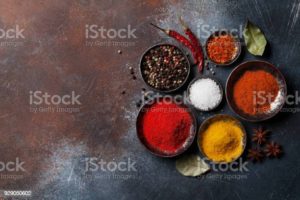In Bengali cuisine kochuri refers to a good sort of stuffed, deep-fried pastries. Kochuri is often full of everything from different sorts of lentils to fish and meat. But while other kachoris have very literal and prosaic names, this particular one full of biuli’r/kolai’er dal has been bestowed a reputation that’s directly poetic and divine. Fortunately, the dish does taste nearly as good because it sounds! Serve this with aloo’r dom or chhola’r dal and prepare to concentrate to your loved ones sing praises for your cooking.
INGREDIENTS
PREP OF THE FILLING
- 200 g kalai’er dal (biuli’r dal or urad dal)
- 60 g water
- 35 g ginger
- 10 g green chillies
- ½ tsp salt
- 8 g mouri (fennel seeds)
COOK THE FILLING
- 20 g vegetable oil
- ¼ tsp kaalo jeere (nigella seeds)
- ½ tsp hing (asafoetida)
- 28 g ginger + chilli paste
- 5 g mouri powder
- 26 g sugar
- 5 g salt
- 320 g kalai’er dal paste
FOR THE DOUGH
- 300 g maida
- 5 g salt
- 12 g sugar
- 20 g oil
- 15 g ginger + chilli paste
- 3 g mouri powder
- 130 g kalai’er dal paste
- 75 g water (approximate)
METHOD
PREPARATION:
Wash, then soak the kalai’er dal overnight in many water.
The next day drain the water thoroughly, and transfer to a grinder jar. Add 60 grams of water and grind it coarsely. If it’s too smooth, the radhaballabhi won’t have any texture. If the grind is just too coarse the kochuri will get punctured and won’t brag .
Grind the fennel seeds quite fine during a mortar pestle, even better during a small spice grinder.
Grind together fresh ginger and green chillies with half a teaspoon of salt until smooth.
MAKE THE DOUGH
In a large bowl weigh out the flour, salt, sugar, ground fennel, 15 grams of the ginger and green chilli paste, and 20 grams of oil. Rub the flour between your fingers to distribute the oil evenly.
Next, add 130 grams of the bottom kolai’er dal. Mix the dal well into the flour. this is often important so you recognize what proportion more water to feature to make the dough. Adding the kolai’er dal and spices to the dough is unusual, but will elevate your radhaballabhis to subsequent level — it is a tip we learnt from dinna (Saptarshi’s maternal grandmother)
Add water. We used 75 grams.
Knead well continuously for five minutes (can be longer if you’re making a bigger batch) until the dough becomes smooth and soft.
Cover the dough with a decent lid or a bowl and let it rest for half-hour.
COOK THE FILLING
Heat a korai or wok and add 20 grams of oil thereto.
Lower the warmth and temper the oil with kalo jeere and hing.
Immediately, add the remainder of the ginger and green chilli paste and fry. you’ll add a splash of water to stop the spices from burning.
Add the remaining ground fennel and stir.
Add the salt and sugar. Fry until the oil separates and therefore the sugar caramelises.
Add the remaining ground kolai’er dal (320 g) and stir to combine . The dal must fry well so as to develop a nutty flavor. Keep stirring patiently, on low heat. you’ll got to scrape the edges of the korai because the dal is extremely sticky. A round-bottomed wok (korai) and a flat metal spatula (khunti) are the simplest tool for the work .
Eventually, the entire paste will form a dry lump. Transfer it to a bowl and spread it bent cool. this is often your radhaballabhi filling.
ASSEMBLY AND FRYING
Using scissors and a weighing scale divide the dough into 45-gram portions. Form them into balls. Our recipe produces 12 balls.
Divide the filling into 20-gram portions.
Flatten the dough using your fingers until it forms a disk large enough to carry the filling. Place the filling at the middle of the disk of dough. Use your fingers to push the dough around the filling in order that the dough engulfs the filling. Seal the top. Roll it between your palms to smoothen out any seams. Coat well with oil (the dough is extremely sticky due to the dal in it) and store on a plate, covered. Watch the video to urge a far better sense of the precise process.
Once all the dough balls are stuffed and prepared , set oil to heat during a korai for deep frying.
Grease your rolling surface and kitchen utensil with oil. Roll with a lightweight hand into 14 cm disks (for 45 gram dough and 20 gram filling). It should neither be too thin nor too thick for the kochuri to possess a crispy outside but a soft inside.
Make sure the oil is extremely hot (200º C). If the oil isn’t hot enough the radhaballabhi won’t brag and can end up hard and greasy.
Lower the kochuri into the oil. Gently press with the jhnajhri hata or perforated spoon until fully hyped up . Turn them over and fry the opposite side. The frying process won’t take quite 40 seconds. Remove from oil and place during a perforated colander or jhuri to permit the steam to flee . Otherwise, the radhaballabhi will lose their crunch and become soggy.
Serve at temperature (yes, they’re not served piping hot) with alu’r dom or chhola’r dal.


0 comments on “RADHABALLABI”Add yours →